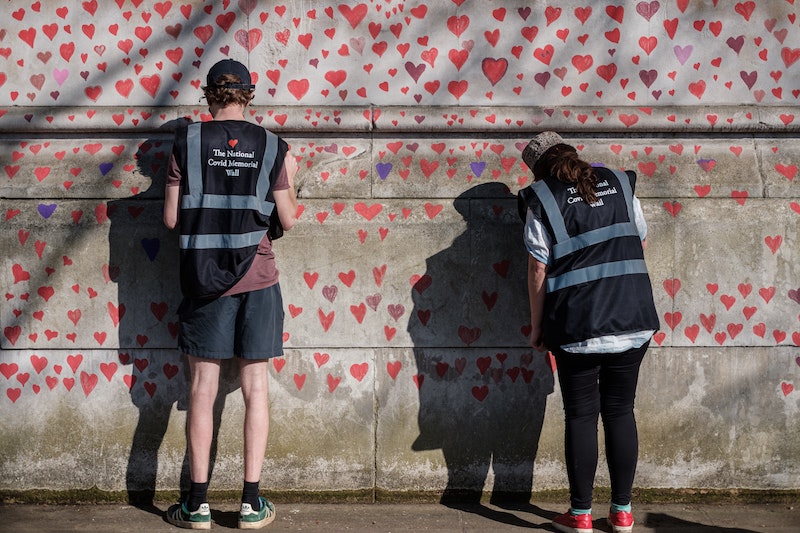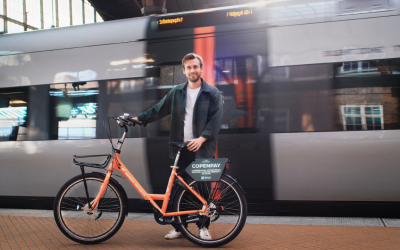Fear is a primary barrier to making the changes that the travel industry – and your DMO – most desperately need during this double crisis.
This is the first of two articles by Frank Cuypers about reimagining tourism and gathering the courage to change following COVID-19. Read the second article here: Getting unstuck: How to bring your DMO and stakeholders beyond fear to reimagine tourism
“Taking a new step, uttering a new word, is what people fear most.”
— Fyodor Dostoyevsky, Crime and Punishment
The travel industry dearly needs new steps and new words from its leaders. Dostoyevsky’s observation rings true: In this time of change, fear is everywhere. COVID-19 has revealed how fragile human systems are, whether in travel, tourism, economics, politics, or destination marketing organizations (DMOs). The disease has, at a grand scale, forced travel to pause. It has grounded airplanes and slowed movement precisely when the climate crisis demands full attention. In this moment of relative stasis, difficult as it is, the travel industry can reset and grow back while building greater resilience.
Amid fear and loss, many travel leaders, including destination marketers, continue to clamour for a better way forward. Those destinations facing an economic emergency are doing everything they can to mitigate the damage to businesses and livelihoods. And yet, while weathering the health crisis, more destination marketers are thinking about how to reimagine tourism, because they know they need to, pandemic or not.
Fear is a primary barrier to reimagining tourism in the wake of COVID-19. History shows that people are more likely to drive positive systemic change, as a collective, when the pain of the status quo finally outstrips the fear of the change they seek. For better or worse, that moment has arrived. In some places, destination marketers and others in the tourism and travel space are actively helping their stakeholders do business differently in the long term by taking specific, courageous actions to reimagine tourism and outline visions of the flourishing future that we at Destination Think have been describing for some time.
You and your DMO can lead your stakeholders toward greater collective resiliency. But you’ll need more than your ideals. Understand fear as the greatest barrier to turning positive intentions into action.
Understand two types of tourism-related fear
Fear has two components: one is fact-based, and the other is psychological. Take the word “overtourism,” for instance. On one hand, you can measure overtourism through data and observation. Anyone can see when there are too many travellers in the same place at the same time. They can find out how visitor pressure damages culture, nature and local ways of life. It’s become an understatement to say that places like Thailand, Barcelona, Amsterdam or Venice have suffered from overtourism. These are commonly accepted facts that can be measured and confirmed again.
On the other hand, the psychological component of fear can lead to scapegoating. In our work with DMO clients at Destination Think, we hear concerns from residents about overtourism or mass tourism in many places around the world – even in destinations that hardly see any tourists at all. People blame tourism for many things that go wrong, even when there is no direct link.
Sometimes tourism falls victim to poor urban planning or place management.
In one remote, sparsely populated American destination, for example, our Place DNA® process revealed local opinions of tourism, which included plenty of support and a few concerns. Some voiced their fears of change. “Please do not tell any more people in the U.S. about [this location],” wrote one worried survey respondent.
In the South Pacific, residents of an urban destination expressed concern about overcrowding at a nearby island. However, research shows that the problem is local. The city dwellers themselves are causing overcrowded ferries and congested parking lots. Sometimes tourism falls victim to poor urban planning or place management.
Practically speaking, it doesn’t matter whether fear is rooted in facts or in psychology. These real emotions need to be expressed and heard. Your DMO needs to listen and respond to concerns from stakeholders, including residents.
Think back to Dostoyevsky and change as the cause of fear. Change often brings uncertainty and loss, and no one likes to lose what they know and love. Some residents and tourism businesses get nervous about the way their place is changing (this happens in virtually every destination we’ve worked with), while travellers fear losing the freedom to travel and to choose their experiences. These are valid perspectives.
In the long run, though, people may not lose the freedom to travel so much as the freedom to choose how to travel. Travel at the expense of others – local communities, environment and culture – will no longer be possible, given the climate crisis. Your destination’s residents and local tourism businesses will drive discussion about how people visit you, and under what circumstances. Your DMO can lead and contribute to that conversation.
Your DMO’s strategy for a more resilient future
COVID-19 and climate change both have a serious effect on the future of travel. Many leaders give necessary leadership through articles and keynotes about restorative, meaningful, regenerative or transformative tourism. At the same time, the systemic shift requires action.
All of us working in this industry share responsibility to make the industry and our planet more resilient. We can overcome fear by helping people see a better future.
How many times have we heard, “This should be the new direction, but our people are not there yet.”?
Too many destination marketers seem to freeze in fear and wait until all their stakeholders, politicians or industry are on board. This is a perfect example of circular reasoning: Refusing to do something new until everyone agrees that it works, even though no one can know the new thing will work until they try it. How many times have we heard, “This should be the new direction, but our people are not there yet.”? Some people are afraid of transforming tourism because it means losing the perceived stability of business as usual. COVID-19 has made one thing clear: it’s no use going back to business as usual. In many places, old ways of business have already been lost. After this crisis resolves, the old usual won’t exist either – and that’s okay.
Others fear the financial fallout and a weakening of their legacies. But some signals of change from big business inspire courage. In the U.S., corporations have long been structured around shareholder primacy – the idea that “corporations exist principally to serve shareholders.” In August 2019, Business Roundtable, an association made up of the CEOs of some of America’s largest companies, including Apple, Walmart, and Marriott, released a new Statement on the Purpose of a Corporation. Their statement outlines “a modern standard for corporate responsibility” by emphasizing a fundamental commitment to all stakeholders. The list of stakeholders includes customers, employees, suppliers, communities and shareholders. “Each of our stakeholders is essential. We commit to deliver value to all of them, for the future success of our companies, our communities and our country.” Such leadership from the top matters because it sets the tone for a wider conversation about the roles of business and travel.
Some places and tourism destinations are already moving onward. We’ve written extensively about Tourism Bay of Plenty’s The Love of Tourism plan, which shows a path to regenerative tourism in New Zealand. Here are a few others:
- The Colorado Tourism Office and their partnership program with the Leave No Trace Center for Outdoor Ethics help visitors learn how to care for the outdoors as they explore.
- The city of Amsterdam is using the doughnut model of economics from Kate Raworth of Oxford University’s Environmental Change Institute as a way to better harmonize the economy with the environment following COVID-19.
- The Central-Eastern European Treaty Organization (CEETO) is a transnational European initiative that enables tourism to protect the environment and preserve the natural assets that draw so many travellers.
- The worldwide hospitality company Accor has partnered with To Good to Go in a program to reduce food waste across hundreds of hotels.
Places and organizations like these are not only working to flatten the COVID-19 curve, they’re also applying that urgency and sense of responsibility to their role in battling the climate crisis.
The way global business is done must change to operate within the Earth’s capacity.
One way to overcome fear within your DMO and among your stakeholders is to collectively build a tourism strategy that leads to outcomes like those listed above. At Destination Think, our strategic model for DMOs during the pandemic has three stages: mitigate, restart and reimagine. Many places have invested in mitigation strategies and are pursuing a tourism restart.
In this incredibly challenging time, it is important to grieve the losses to human life and well-being. The pandemic has revealed that our communities and places are vulnerable. Economic wounds will also need time to heal.
The depth of the tragedy emphasizes that reimagining is urgently needed. To reimagine together is to build resiliency for the long term. Finding empathy with tourism stakeholders is going to be a critical skill for the 2020s. A successful strategy to reimagine tourism will help your DMO allay fears that stem from not knowing how to implement change, which new ideas to use, which should be removed, and what skill sets will be necessary. No one can avoid uncertainty, but everyone can manage it with the courage that comes from mutual support.
A strategy to reimagine tourism will show your stakeholders how the future of travel might look – with their full participation.
Next, read Frank’s follow-up article: Getting unstuck: How to bring your DMO and stakeholders beyond fear to reimagine tourism
Here are some more resources to help you think strategically through COVID-19.
Strategic planning for your DMO
- 3 recovery phases for your destination and DMO: Mitigate, restart, reimagine
- 4 takeaways for your DMO’s strategic planning during COVID-19
- Beyond COVID-19: Strategic thinking to prepare your DMO for the future
Mitigation
- Mitigate COVID-19’s impact on your destination: Phase 1 of 3
- Community leadership: 4 ways your DMO can rise to the moment
- COVID-19 Q+A: How can my DMO engage stakeholders during a constant crisis?
Restart
- Restart your destination’s tourism industry: Phase 2 of 3
- Your DMO’s role in the slow-motion tourism restart
- Should your DMO urge domestic travel right now?
Reimagine
- Reimagine what tourism and travel can become: Phase 3 of 3
- Reimagining travel means preventing tourism leakage
- 6 ways destinations are inventing a better life after COVID-19
Feature image credit: Ehimetalor Akhere Unuabona on Unsplash









A great article. I love graphic play on flattening the curve, a concept that COVID-19 has brought into mainstream understanding but works well here. There is so much to do going forward and the stage has been set for us – lets hope the majority take positive action, not just think about it, to reset tourism for a stronger, healthier future, with new measures of success and ways to address future challenges.
If we are to address climate change, we need to stop mass tourism. It’s way too accessible. Air travel, ground transportation, cruise ships. There’s a great disconnect when we talk about economic interests and environmental needs. If we’re to save our planet $$$ interests must yield!